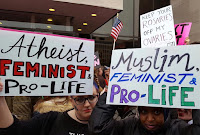Three takeaways from NIFLA v. Becerra
Yesterday, the Supreme Court handed down a 5-4 decision in favor of the pregnancy centers challenging a California law that required them to post signage advertising state-funded abortion. The majority opinion, which found that the pregnancy centers were protected by the First Amendment, was written by Justice Thomas and joined by Chief Justice Roberts and Justices Kennedy, Alito, and Gorsuch. The dissent was written by Justice Breyer and joined by Justices Ginsburg, Kagan, and Sotomayor.
The case has been amply covered by media of all stripes, so I’ll just offer a few thoughts.
We desperately need a pro-life woman on the Court. All three women Justices—who I should note are past childbearing age and come from high-SES families—shamefully voted against the charities that aid low-income mothers in crisis. Already, pro-abortion groups are touting the sad fact that the Court’s free speech supporters are all male. This must change. If you haven’t already done so, sign the #NextNominee petition to make our next Justice a pro-life woman! A vacancy could come any day.
The central disagreement was how to apply Casey. In the 1992 case of Planned Parenthood v. Casey, the Court held that states could require abortion businesses to disclose the procedure’s risks and alternatives without running afoul of the First Amendment. Abortion supporters argued that California’s law was analogous to the law in Casey. I previously offered my counter-argument, which I’m pleased to see is similar to the majority ruling:
The licensed notice at issue here is not an informed consent requirement or any other regulation of professional conduct. The notice does not facilitate informed consent to a medical procedure. In fact, it is not tied to a procedure at all. It applies to all interactions between a covered facility and its clients, regardless of whether a medical procedure is ever sought, offered, or performed. If a covered facility does provide medical procedures, the notice provides no information about the risks or benefits of those procedures. Tellingly, many facilities that provide the exact same services as covered facilities—such as general practice clinics, see §123471(a)—are not required to provide the licensed notice.
The dissent’s counter-argument rests on the claim that childbirth, like abortion, is a “medical procedure that involves certain health risks.” Without getting into the longstanding feminist debate over the medicalization of childbirth, the notion that birth is a medical procedure is certainly news to all the mothers who’ve given birth without the involvement of any medical professional whatsoever. And while no one doubts that childbirth has risks, going to a pregnancy center does not in any way increase those preexisting risks; if anything, it decreases them by giving women access to free ultrasound exams and other resources. By contrast, the risks of abortion are the creation of the abortionist, and therefore the abortionist should bear the burden of explaining those risks.
Justice Kennedy’s concurrence stole the show. The majority did not explicitly rule on the question of whether California’s law was meant to discriminate against pro-life people (i.e., unconstitutional viewpoint discrimination), but of course it was. The Justices in the majority debunked the neutral rationales California put forward; for instance, they saw through the argument that California just wants to educate low-income women, noting that if that were the true motivation, the law would not have exempted most clinics that serve the poor.
But Justice Kennedy took it a step further in his concurring opinion, which was joined by all the majority Justices save Thomas (emphasis mine):
This separate writing seeks to underscore that the apparent viewpoint discrimination here is a matter of serious constitutional concern. See ante, at 6, n. 2. The Court, in my view, is correct not to reach this question. It was not sufficiently developed, and the rationale for the Court’s decision today suffices to resolve the case. And had the Court’s analysis been confined to viewpoint discrimination, some legislators might have inferred that if the law were reenacted with a broader base and broader coverage it then would be upheld.
It does appear that viewpoint discrimination is inherent in the design and structure of this Act. This law is a paradigmatic example of the serious threat presented when government seeks to impose its own message in the place of individual speech, thought, and expression. For here the State requires primarily pro-life pregnancy centers to promote the State’s own preferred message advertising abortions. This compels individuals to contradict their most deeply held beliefs, beliefs grounded in basic philosophical, ethical, or religious precepts, or all of these.
Check out that last sentence. Four Supreme Court Justices just acknowledged that an anti-abortion stance can be based on philosophical and ethical precepts rather than just religious ones! Go us!
P.S.: Want more NIFLA v. Becerra coverage? NIFLA itself is holding a webcast tomorrow night.



Leave a Reply
Want to join the discussion?Feel free to contribute!